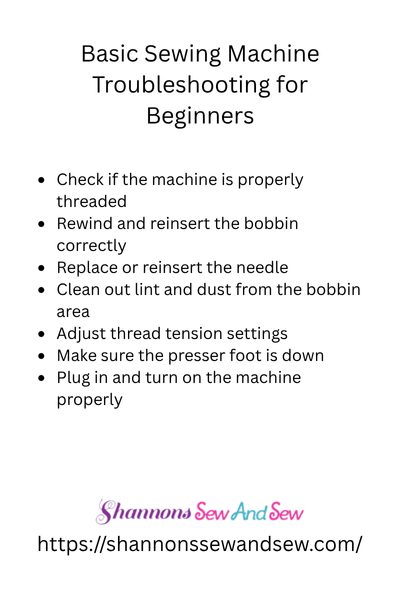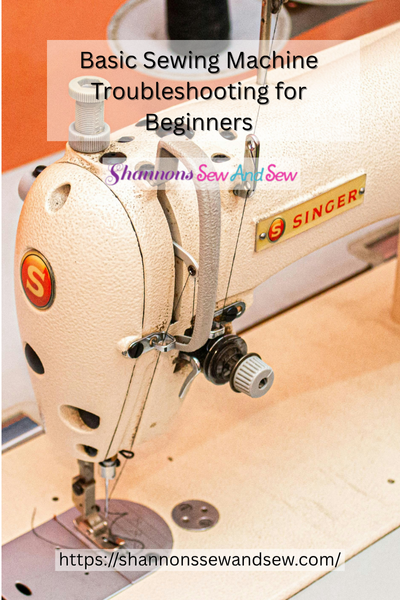Sewing For Beginners
Basic Sewing Machine Troubleshooting for Beginners
If you’re just starting out and finding yourself tangled up in thread (literally), basic sewing machine troubleshooting for beginners is exactly where you need to start. Trust me, I’ve been there—frustrated, confused, and this close to throwing my sewing machine out the window. But don’t worry, you’re not alone. Let’s chat about what can go wrong and how you can fix it without pulling your hair out.
Read More About Basic Sewing Machine Troubleshooting for Beginners

So, Why Won’t My Sewing Machine Work?
You finally sit down to sew, you’re feeling all excited, you push that foot pedal—and nothing. Or worse, it sews for a second and then the thread turns into a bird’s nest underneath. Sound familiar? That’s when basic sewing machine troubleshooting for beginners comes to the rescue.
One time, I spent an hour trying to figure out why my machine kept skipping stitches. I rethreaded the top thread five times before realizing… the needle was bent. Yup. That tiny, innocent-looking needle caused a world of chaos. Lesson learned: sometimes it’s the little things!
More Things to Know About Basic Sewing Machine Troubleshooting for Beginners

Thread Tension Troubles
Let’s talk about thread tension. Honestly, it can be a pain, especially when you’re new. If your stitches are too tight or super loose, chances are your thread tension is off. You don’t need a PhD to fix it though.
Try adjusting the tension dial just a little at a time. Most machines are set to 4 or 5 for a balanced stitch. If your bottom thread is showing on top, lower the tension. If the top thread is looping on the bottom, raise it. It’s like tuning a guitar—small tweaks make a big difference.
Is Your Machine Properly Threaded?
Here’s a biggie in basic sewing machine troubleshooting for beginners: improper threading. I know, it sounds too simple to be the problem, but it happens all the time. If you’re in a rush (or distracted by a podcast like I usually am), it’s easy to miss a hook or guide.
Turn off your machine, take a breath, and rethread everything—both the top thread and bobbin. Follow your manual if you’re unsure. And don’t forget to raise the presser foot while threading so the tension disks are open. That one trick alone saved me so many headaches.
The Bobbin Zone
Ah, the bobbin. Small but mighty. If it’s wound unevenly or inserted the wrong way, your stitches will rebel. In one of my early projects, I couldn’t figure out why the thread kept jamming. Turns out, I’d put the bobbin in backward. Who knew direction mattered so much?
Make sure your bobbin is wound smoothly and that it’s turning the right way in the case. Your machine’s manual will show you exactly how it should sit. And always use the right type of bobbin for your model—universal ones aren’t always universal, despite the name.
Needles: The Unsung Heroes
Let’s not underestimate the humble needle. If you’re sewing denim with a needle made for silk, things won’t go well. Been there, done that, ripped the seam. For basic sewing machine troubleshooting for beginners, always ask yourself: “Is my needle right for this job?”
Change your needle regularly, especially if it’s bent or dull. A fresh needle can make your machine run like a dream. I like to swap mine every couple of projects, just to be safe.
That Dreaded Jam
Nothing kills your sewing vibe faster than a thread jam. You’re cruising along and BAM—the machine groans, the needle stops, and you’re stuck. First, don’t panic (easier said than done, right?). Stop pressing the pedal and turn everything off.
Then, gently remove the fabric—don’t yank it—and check under the needle plate. You’ll probably find a wad of tangled thread. Snip it out with some small scissors, rethread your machine, and you’re back in business. It’s annoying, yes, but it’s fixable.
When to Call in Reinforcements
Sometimes, even with all the basic sewing machine troubleshooting for beginners tricks, the problem just won’t budge. If your machine makes weird noises, smells funny, or flat-out refuses to sew, it might be time for a tune-up.
Taking your machine to a repair shop doesn’t mean you’ve failed—it means you care enough to get it working right. I took mine in last year when the timing went off, and it came back purring like a kitten. Best $40 I spent all year.
Basic Sewing Machine Fixes Every Beginner Should Know
Why Basic Sewing Machine Troubleshooting for Beginners Is a Must-Know Skill
Sewing should be fun, not frustrating. Learning basic sewing machine troubleshooting for beginners gives you the power to keep creating without constantly hitting roadblocks. And hey, the more you troubleshoot, the more confident you’ll get. Before you know it, you’ll be the one giving advice to the next beginner who’s stuck on their first jam.
Just remember—every sewer has had that moment of “What on earth is wrong with this thing?!” You’re in good company. Now go thread that needle, power up your machine, and show those stitches who’s boss. You’ve got this!




















